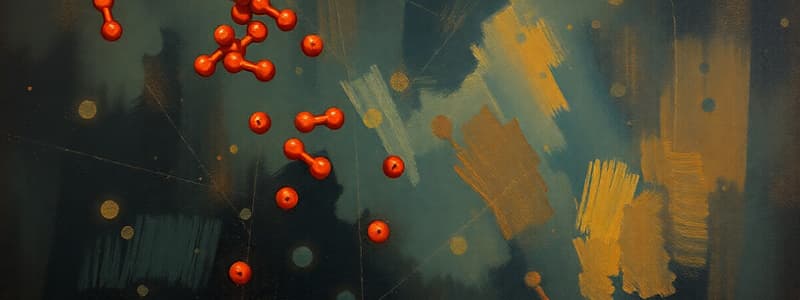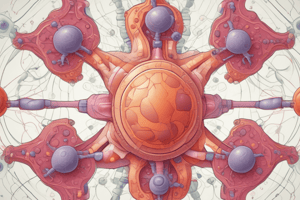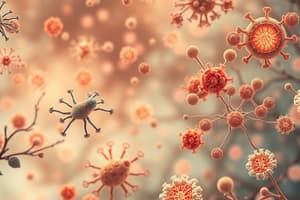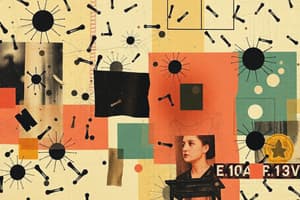Podcast
Questions and Answers
Which of the following cells does NOT mature primarily in the bone marrow?
Which of the following cells does NOT mature primarily in the bone marrow?
- Basophils
- Neutrophils
- Eosinophils
- T lymphocytes (correct)
What is the main role of costimulators in T cell activation?
What is the main role of costimulators in T cell activation?
- To act as a checkpoint ensuring T cell activation only occurs in the presence of a genuine threat. (correct)
- To provide the initial signal for T cell activation, recognizing specific antigens.
- To induce the production of cytokines by macrophages.
- To activate B cells to produce antibodies.
Which of the following is NOT a primary lymphoid organ?
Which of the following is NOT a primary lymphoid organ?
- Bone marrow
- Spleen (correct)
- Thymus
- Fetal liver
Which of the following is NOT a major function of antibodies?
Which of the following is NOT a major function of antibodies?
What is the main function of the thymus gland?
What is the main function of the thymus gland?
Which of these immunoglobulin classes is primarily involved in antibody-dependent cellular cytotoxicity (ADCC) mediated by NK cells?
Which of these immunoglobulin classes is primarily involved in antibody-dependent cellular cytotoxicity (ADCC) mediated by NK cells?
Why is the thymus considered a vestigial organ in adults?
Why is the thymus considered a vestigial organ in adults?
During a humoral immune response, which part of the antibody molecule remains constant while the heavy chain region might change?
During a humoral immune response, which part of the antibody molecule remains constant while the heavy chain region might change?
Which immunoglobulin class is responsible for stimulating mast cells and eosinophils, leading to the release of inflammatory mediators?
Which immunoglobulin class is responsible for stimulating mast cells and eosinophils, leading to the release of inflammatory mediators?
What does the term 'hemopoietic progenitor cells' refer to?
What does the term 'hemopoietic progenitor cells' refer to?
What is the primary difference between the primary and secondary humoral immune responses?
What is the primary difference between the primary and secondary humoral immune responses?
What is the function of the spleen in the immune system?
What is the function of the spleen in the immune system?
Which of the following is NOT a typical characteristic of the maturation process of T lymphocytes in the thymus?
Which of the following is NOT a typical characteristic of the maturation process of T lymphocytes in the thymus?
What happens to the majority of T lymphocytes that enter the thymus?
What happens to the majority of T lymphocytes that enter the thymus?
Which of these is NOT a component of the complement cascade?
Which of these is NOT a component of the complement cascade?
What is the function of MHC molecules in the immune system?
What is the function of MHC molecules in the immune system?
How do antibodies contribute to opsonization?
How do antibodies contribute to opsonization?
Which of the following statements accurately describes the role of leukocytes in the immune system?
Which of the following statements accurately describes the role of leukocytes in the immune system?
Based on the information provided, which type of leukocyte is an exception to the general rule of maturation in the blood?
Based on the information provided, which type of leukocyte is an exception to the general rule of maturation in the blood?
What is the primary mechanism by which complement activation contributes to immune defense?
What is the primary mechanism by which complement activation contributes to immune defense?
Which of the following statements is TRUE about the relationship between antibodies and immunoglobulins?
Which of the following statements is TRUE about the relationship between antibodies and immunoglobulins?
What is the main role of the variable domain in an antibody's structure?
What is the main role of the variable domain in an antibody's structure?
Which component of the antibody structure contains the most amino acids?
Which component of the antibody structure contains the most amino acids?
How many light chains are present in a typical antibody monomer?
How many light chains are present in a typical antibody monomer?
What type of bonds link the polypeptide chains in an antibody?
What type of bonds link the polypeptide chains in an antibody?
Which part of the antibody determines its classification into different classes?
Which part of the antibody determines its classification into different classes?
What is formed when two heavy chains of an antibody are attached to each other?
What is formed when two heavy chains of an antibody are attached to each other?
What feature differentiates the light chains from the heavy chains in structure?
What feature differentiates the light chains from the heavy chains in structure?
In an antibody, which domain is larger in size?
In an antibody, which domain is larger in size?
What is the significance of the antigen-binding site in an antibody's function?
What is the significance of the antigen-binding site in an antibody's function?
Which type of chain is directly involved in the formation of the antigen-binding site?
Which type of chain is directly involved in the formation of the antigen-binding site?
What is the primary role of antibodies in relation to pathogens within infected cells?
What is the primary role of antibodies in relation to pathogens within infected cells?
Which type of T lymphocyte is primarily responsible for killing infected cells directly?
Which type of T lymphocyte is primarily responsible for killing infected cells directly?
How do infected cells communicate their infection status to the immune system?
How do infected cells communicate their infection status to the immune system?
What role do helper T lymphocytes (CD4 cells) play in immune response?
What role do helper T lymphocytes (CD4 cells) play in immune response?
What process prepares antigens for destruction by innate immunity?
What process prepares antigens for destruction by innate immunity?
Which cells are primarily responsible for recognizing foreign antigens displayed on infected cells?
Which cells are primarily responsible for recognizing foreign antigens displayed on infected cells?
What is an incorrect statement regarding the function of antibodies?
What is an incorrect statement regarding the function of antibodies?
Which immune cells are NOT involved in directing the activities of the immune response?
Which immune cells are NOT involved in directing the activities of the immune response?
What best describes the function of opsonization in the immune response?
What best describes the function of opsonization in the immune response?
Which of the following cells does NOT belong to the adaptive immune system?
Which of the following cells does NOT belong to the adaptive immune system?
Flashcards
Leukocytes
Leukocytes
White blood cells involved in immune response, mainly released into the blood after maturity.
Chemotaxis
Chemotaxis
The movement of cells towards chemical signals, aiding immune response.
Antibodies
Antibodies
Proteins produced by plasma cells to identify and neutralize foreign objects.
Opsonization
Opsonization
Signup and view all the flashcards
Complement system
Complement system
Signup and view all the flashcards
Membrane Attack Complex (MAC)
Membrane Attack Complex (MAC)
Signup and view all the flashcards
Major Histocompatibility Complex (MHC)
Major Histocompatibility Complex (MHC)
Signup and view all the flashcards
Lymph
Lymph
Signup and view all the flashcards
Costimulator
Costimulator
Signup and view all the flashcards
Primary Lymphoid Organs
Primary Lymphoid Organs
Signup and view all the flashcards
Fetal Liver
Fetal Liver
Signup and view all the flashcards
Thymus Gland
Thymus Gland
Signup and view all the flashcards
Thymosin
Thymosin
Signup and view all the flashcards
Secondary Lymphoid Organs
Secondary Lymphoid Organs
Signup and view all the flashcards
T cell maturation
T cell maturation
Signup and view all the flashcards
Spleen
Spleen
Signup and view all the flashcards
Antigen-Antibody Complex
Antigen-Antibody Complex
Signup and view all the flashcards
Extracellular Environment
Extracellular Environment
Signup and view all the flashcards
Cell-Mediated Immunity
Cell-Mediated Immunity
Signup and view all the flashcards
Cytotoxic T Lymphocytes (CD8 cells)
Cytotoxic T Lymphocytes (CD8 cells)
Signup and view all the flashcards
Helper T Lymphocytes (CD4 cells)
Helper T Lymphocytes (CD4 cells)
Signup and view all the flashcards
Macrophages
Macrophages
Signup and view all the flashcards
Pathogens
Pathogens
Signup and view all the flashcards
Antigens
Antigens
Signup and view all the flashcards
Innate Immunity
Innate Immunity
Signup and view all the flashcards
Immunoglobulin Classes
Immunoglobulin Classes
Signup and view all the flashcards
Switching Ig Isotype
Switching Ig Isotype
Signup and view all the flashcards
IgA Structure
IgA Structure
Signup and view all the flashcards
Neutralization
Neutralization
Signup and view all the flashcards
Primary vs Secondary Immune Response
Primary vs Secondary Immune Response
Signup and view all the flashcards
Classes of Antibodies
Classes of Antibodies
Signup and view all the flashcards
Antibody Structure
Antibody Structure
Signup and view all the flashcards
Heavy Chains
Heavy Chains
Signup and view all the flashcards
Light Chains
Light Chains
Signup and view all the flashcards
Variable Domain
Variable Domain
Signup and view all the flashcards
Constant Domain
Constant Domain
Signup and view all the flashcards
Antigen-Binding Site
Antigen-Binding Site
Signup and view all the flashcards
Monomer
Monomer
Signup and view all the flashcards
Disulfide Bonds
Disulfide Bonds
Signup and view all the flashcards
Y-Shaped Molecule
Y-Shaped Molecule
Signup and view all the flashcards
Study Notes
Learning Objectives
- Define all terms listed in the Definitions section (page 2).
- Understand the adaptive immune response's key properties.
- Compare and contrast humoral and cell-mediated adaptive immunity, identifying the involved cells.
- Define antigen and antigenic determinant.
- Compare and contrast Class I and Class II MHC/HLA molecule cellular expression and function.
- Describe antigen-presenting cell function and the cell types that act as APCs.
- Define self-tolerance and immunocompetence.
- Define clonal selection.
- Illustrate antibody structure, including heavy and light chains, variable and constant domains, Fab and Fc regions.
- Define antibody affinity and avidity.
- Differentiate between five antibody (immunoglobulin) classes.
- List and describe antibody effector functions.
- Compare and contrast B cell activation in primary and secondary immune responses.
- Describe the role of immunological memory in both responses.
- Differentiate between CD4 helper T cells and CD8 cytotoxic T cells, including their functions.
- Describe the process of CD4 and CD8 T cell antigen recognition.
- Describe T cell activation processes.
- Define costimulation.
- List and describe the functions of TH1, TH2, TH17, and Treg effector CD4 T cells.
- Describe T cell-mediated immunological memory.
- Outline the timecourse of the immune response to an infection.
- Define inflammation.
- Explain immune system interactions with infection timecourses.
- Describe the location and functions of Interleukin-2, CD3, CD28, CD20, CD40, PD-1, glucocorticoid, Interleukin-17, CTLA4.
Definitions (Page 2)
- Immunity: The ability to resist damage from foreign substances (microorganisms, chemicals, or cancer cells).
- Innate immunity: A nonspecific immune system branch responding similarly to each exposure to foreign substances.
- Adaptive immunity: A specific immune system branch, responding faster and stronger each time it encounters a foreign substance.
- Specificity: The ability of adaptive immunity to target a specific substance.
- Diversity: The large number of lymphocytes exhibiting different antigen-specificities.
- Memory: The ability of adaptive immunity to remember previous encounters with a particular substance and respond more effectively.
- Antigens: Substances stimulating adaptive immunity (foreign or self-antigens).
- Foreign antigens: Substances not produced by the body. Examples include pollen, animal dander, food components, and microorganisms.
- Self-antigens: Molecules produced by the body potentially stimulating either beneficial or harmful responses (including tumor and autoimmune responses).
- Antibodies: Proteins produced by plasma cells (differentiated B cells) in response to antigens, also known as immunoglobulins.
- Opsonization: Rendering pathogens susceptible to phagocytosis via antibody or complement protein binding.
- Complement: A group of ~20 proteins (~10% plasma globulin) mediating cell lysis, opsonization, and immune cell recruitment.
- Major Histocompatibility Complex (MHC) molecules: Glycoproteins found on most body cells, displaying processed antigens for immune cell recognition.
- Costimulator: A molecule on antigen-presenting cells, providing a second signal for naive T cell activation.
- Lymphocytes: White blood cells derived from myeloid/lymphoid lineages. (Neutrophils, eosinophils, basophils, monocytes, erythrocytes, platelets).
Cells, Tissues, and Organs of the Immune System
- Hematopoietic stem cells give rise to all blood cells, differentiating into myeloid and lymphoid lineages.
- Myeloid lineage forms neutrophils, eosinophils, basophils, monocytes, erythrocytes, and platelets.
- Lymphoid lineage forms T and B lymphocytes and natural killer (NK) cells.
- Thymus gland releases hormones like thymosin, promoting T cell maturation.
- Lymphoid stem cells migrate to thymus for differentiation
- Spleen filters blood, removing aged erythrocytes and pathogens.
- White pulp contains B and T cells, initiating an immune response.
- Red pulp contains macrophages, clearing cellular debris.
Cells of Adaptive Immunity
- Phagocytic cells (monocytes/macrophages): Engulf and destroy pathogens, using phagocytosis to digest ingested material within the cell's lysosomes.
- Dendritic cells: Bridge between innate and adaptive immunity, acting as antigen-presenting cells (APCs) to activate T and B cells by displaying processed antigens on their surfaces to initiate an adaptive immune response.
- Lymphocytes (B and T cells): Respond specifically to antigens, initiating an adaptive immune response.
Studying That Suits You
Use AI to generate personalized quizzes and flashcards to suit your learning preferences.




